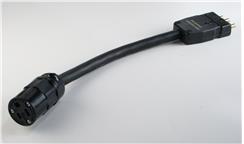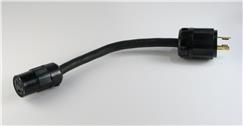PERSONAL EDIT: I'm leaving my super long and reasonably questionable post after this in case it might help, but hopefully this is a better solution and the original post can be skipped over:
How much light do you need? Could you do the
effect with something like a VNSP
MR16 that is both low
power (less radiant heat) and narrow
beam angle (can have all of the light go through the hole and still be mounted reasonably far away from the
platform).
MR16's can be surprisingly bright and come in really narrow beam angles. You need to pay attention to operating
voltage as a lot of
MR16 lamps don't run on 120VAC, but it could be the ticket for your
effect. As always be safe and try things out incrementally up to and in excess of expected use case to ensure
safety.
ORIGINAL SUPER LONG POST:
The first question is how long is the
effect on for and at what
intensity? If it's at full for 60 minutes that might be a problem. 15% for 30 seconds, maybe not. Given your concern about heat I'm going to continue based on the assumption that the
fixture is on for a while at a decent
intensity.
Do you have access to any
ellipsoidal fixtures with narrow beam angles (Source 4, Shakespeare, SPX,
360Q,
etc...)? They should work fine with your
current dimming
system and would allow you to narrow the light's beam. This would reduce the amount of light (and therefore heat) directed at the
platform while increasing the amount of light the goes through the hole. The increase of light going through the hole may allow you to run the
fixture at a lower
intensity further reducing the amount of heat the
platform has to absorb. Doing rather shady math, mostly in my head, a 14 degree source 4 should work for the application you've described provided that a light source ~2.5 feet from the hole in the
platform would give you a wide enough effective
beam angle after the hole in the
platform worked basically as a 5" round
gobo (9.5 degrees? it's been a while since I've calculated this kind of stuff).
Regardless of the
fixture you select, while testing this
effect I would closely
monitor the
platform. Before you completely OK this
effect, step up slowly until you're running the
fixture at a
bit more
intensity than you think you'll possibly need for a
bit longer than you think you'll possibly need to run it (keep in mind run times in rehearsals as you may be asked to have a look up for much longer than it's used in the show). Then see how much heat is transferred to the
platform. If you can touch it with your bare
hand immediately afterwards then it's probably safe provided you can ensure that the
platform is never subjected to more heat than you tested for, which is admittedly hard. Patching the
channel controlling the
effect so it's limited to a maximum
intensity of whatever you deem safe and necessary to do the
effect is a really good idea (why give a board op the ability to run the
fixture at 100% when 50% will do?). If, during your testing, the
platform starts smoking or you can feel the resonant heat in the
platform through thick welding gloves, then you need to figure out a different way to do this. If it's somewhere in between those options (the most likely situation) then it's a decision you, and any other technical staff, have to make based on what you think the risks are, how qualified you are to make that decision, how much risk of something going wrong you're permitted and willing to take on (insurance may have a say in that), how much this
effect really needs to happen, and what other qualified people agree with your assessment of the risks involved. That may sound scary, actually it probably should, but that's the kind of information you'd be asked for if something did go awry.
Obviously take precautions during the testing process. If you have any suspicion that the light will be too hot for the
platform you should have a person right next to it with a fire extinguisher and another person that can turn the light off at the first sign of danger.
This is a less scientific process than I'd like, but if you err on the cautious side of both the physical
safety of the
effect and the inherent
safety of the people operating the it then this is certainly something that can be done in a safe and controlled way.




